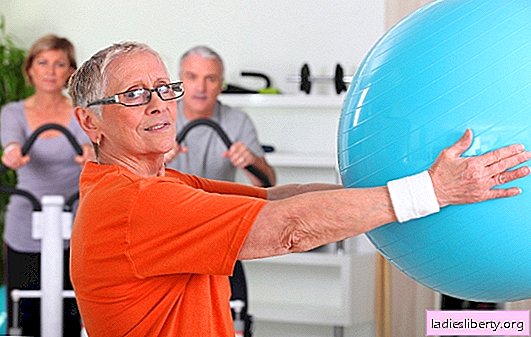
Therapeutic gymnastics after a stroke is an important stage of rehabilitation. It helps to improve blood flow, normalizes metabolic processes, and reduces stagnation of blood inside tissues.
The implementation of gymnastics after a stroke is included in the planned rehabilitation measures along with medications, physiotherapeutic procedures, diet, daily routine.
A set of exercises after a stroke
Prior to performing any gymnastics after a stroke, you should find out the recommendations of the attending specialist. He will give advice on choosing the best training, talk about the details and stages of its implementation. To achieve a positive result, it is necessary to approach each patient individually. The patient must clearly comply with the general requirements for medical exercises. This gymnastics is quite simple in execution, but it can give a positive effect.
Passive gymnastics after a stroke
After the illness during the first few days, the patient needs rest, gymnastics is permissible, but only passive. Its meaning is that the training itself for the patient is done by those who are next to him, bend and unbend his limbs. Exercises begin with the fingers of a paralyzed limb, then a healthy one.
Next, go to the rotational movements of the brush. They are held in all directions. Then you need to bend and unbend your arms at the elbows, and in the end proceed to the shoulders. Movements are made in different directions, rotation. Gymnastics for the legs is carried out in the same way.
To eliminate muscle spasm, they are fixed for a short period of time in an unbent position. A hand or fingers are attached to a stick, fixed in an unbent state, so do the rest of the body. Fixation is carried out no more than half an hour a day with the condition that the patient does not feel discomfort.
The patient himself performs "mental" gymnastics. Such training allows you to accelerate the rehabilitation of the motor center. To do this, it is necessary to imagine in his thoughts that he squeezes and unclenches his palms. Thus, a new motor center is formed in the brain. It is required to clearly present the picture and do it as often as possible. It must be believed that the consequences of the disease can be dealt with.

Active gymnastics
Active gymnastics lying involves the following set of exercises:
• Normal extension and flexion of the extremities, motor activity in the shoulder and hip joints.
• Rotation of the indicated segments. Made through those who care for the sick. Close imitate the physical activity that he carries out in a healthy state.
• Training for the rehabilitation of the functioning of the arm. Spasmodic limbs are stretched by means of a longet and other devices. For these purposes, the arm is first bent, and then slowly unbent and fixed with a bandage to a flat board. Such manipulations are performed in several stages with the overlying parts of the upper limbs. In a similar position, the arm is fixed for 30 minutes (more is permissible if the patient does not have pain).
• A towel should be hung on top of the bed. Such training is available for people with restored functioning of the hand. To do this, you need to grab a towel with your hand and make all kinds of movements. Over time, it will rise higher and doing the training is complicated by the patient’s own mass.
• A ring (diameter 35 cm) is made from a medium-sized rubber strip. Through such a device, various types of gymnastics are performed. The ring can be thrown between the hands, forearms, arms and legs and other objects. At the same time, the gum is stretched by diluting its ends together.
• To eliminate the spasm of the leg muscles, a rigid roller is placed in the popliteal part, the dimensions of which become larger over time. In this way, muscle tension is achieved and the amount of motor activity increases.
• Grasping the legs above the ankle, bending and unbending the legs at the knees by sliding the feet on the bed.
• While in bed, slowly extend your arms above your head and try to grab the headboard. Then do incomplete pull-ups, stretching the feet and fingers.
• Eye training. There is a restoration of the motor activity of the eyeballs and adaptation of visual function. To do this, carry out eye movements in a circle in the direction of 3-6 times. Repeat the manipulation, closing the eyelids.
• Fixing the gaze at one point with further rotation, nodding and movements of the head in a circle, without taking off from this point.

Active gymnastics
Such training is aimed at the rehabilitation of conscious motor activity of the upper limbs, strengthening the spinal muscles and preparing the lower limbs for movement. Her technique is as follows:
• The patient is transferred to a sitting position, with his hands he clings to the edges of the bed. During inspiration, he bends in the back, stretching the body in a state of tension. In the process of exhalation comes relaxation. Repeat several times.
• The starting position is sitting on the bed, legs need to be raised and lowered in turn. First left, and then right foot 3-7 times.
• In a sitting position, the arms are pulled back. In the process of inhalation, it is necessary to make the maximum combination of the shoulder blades with each other, while throwing the head back. During exhalation, relaxation occurs.

Active gymnastics in a standing position
Through such exercises, subtle movements are restored after a stroke in order to eliminate neurological disorders to the maximum. It is carried out after the expansion of motor activity and partial rehabilitation of the patient. These exercises include:
• Lifting a matchbox from the floor. This will help to develop conscious subtle movements.
• Starting position with arms down. During inhalation, you should raise your hands above your head, doing sipping and standing on your fingers. In the process of exhalation, relaxation occurs, the body bends down and falls. Repeat the training 3-7 times.
• Flexion-extension of the hands into a fist by means of an expander with simultaneous abduction of hands from the body.
• In a standing position, legs spaced shoulder-width apart, hands stacked on a belt. Make body tilts on the sides.
• In the same position, perform the exercise "scissors" (in turn move extended crossed arms to the opposite side).
• Squats with interconnected feet. When doing the exercise, you should keep your back evenly and do not tear off your heels.
• In the process of doing gymnastics, which relates to the rehabilitation of subtle movements, it is permissible to continue the set of exercises from the previous stages, in particular, when they help strengthen the muscle and expand the amount of motor activity. Physiotherapy exercises with light dumbbells and strength exercises are allowed.
In order for such a training to have a rehabilitation character, it must be an element of the patient's lifestyle.

The importance of gymnastics after a stroke
Gymnastics with a stroke is important in preventing adverse effects, forming the patient's adaptation to self-care, and mastering lost skills. A long time of forced inactivity in the bed is fraught with the appearance of dangerous complications.
The complex of these exercises can prevent:
• the formation of pressure sores on the buttocks, back;
• congestive pneumonia;
• the appearance of heart failure;
• atrophy of non-functioning muscles;
• the formation of blood clots with further embolism in important organs;
• muscle spasms with high tone during paresis and spastic paralysis, the occurrence of contractures.
Gymnastics after a stroke has a positive effect on microcirculation and metabolism within the body, reduced due to a past illness. It makes it possible to restore motor activity, in the future it will provide an opportunity to draw, write, use utensils and household appliances. Normalizes the functioning of internal organs, favorably affects speech rehabilitation.
Gymnastics after a stroke is characterized by a positive effect - motor activity in paralyzed areas of the body helps to disperse blood, prevents it from stagnating, and also helps to restore muscle memory. However, one should not expect that only a given set of exercises or drug therapy will save from the disease. You need to follow a comprehensive rehabilitation course.











